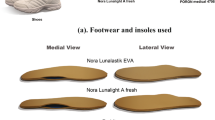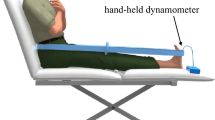Abstract
OBJECTIVE: To investigate plantar pressure differences between obese and non-obese adults during standing and walking protocols using a pressure distribution platform.
SUBJECTS: Thirty-five males (age 42.4±10.8 y; 67–179 kg) and 35 females (age 40.0±12.6 y; 46–150 kg) divided into obese (body mass index (BMI) 38.75±5.97 kg/m2) and non-obese (BMI 24.28±3.00 kg/m2) sub-groups, respectively.
MEASUREMENTS: Data collection was performed with a capacitive pressure distribution platform with a resolution of 2 sensors/cm2 (Emed F01, Novel GmbH, München). The measurement protocol included half and full body weight standing on the left, right and both feet, respectively, and walking across the platform, striking with the right foot. Pressures were evaluated for eight anatomical sites under the feet.
RESULTS: For both men and women, the mean pressure values of the obese were higher under all anatomical landmarks during half body weight standing. Significant increases in pressure were found under the heel, mid-foot and metatarsal heads II and IV for men and III and IV for women. Foot width during standing was also significantly increased in obese subjects. For walking, significantly higher peak pressures were also found in both obese males and females.
CONCLUSION: Compared to a non-obese group, obese subjects showed increased forefoot width and higher plantar pressures during standing and walking. The greatest effect of body weight on higher peak pressures in the obese was found under the longitudinal arch of the foot and under the metatarsal heads. The higher pressures for obese women compared to obese men during static weight bearing (standing) may be the result of reduced strength of the ligaments of the foot.
This is a preview of subscription content, access via your institution
Access options
Subscribe to this journal
Receive 12 print issues and online access
$259.00 per year
only $21.58 per issue
Buy this article
- Purchase on Springer Link
- Instant access to full article PDF
Prices may be subject to local taxes which are calculated during checkout



Similar content being viewed by others
References
Frankel VH, Nordin M . The biomechanics of the skeletal system Lea & Febiger; Philadelphia, PA 1987
Felson DT . Weight and osteoarthritis J Rheum 1995 22: 7–9.
Messier SP, Ettinger WH Jr, Doyle TE, Morgan T, James MK, O'Toole ML, Burns R . Obesity: effects on gait in an osteoarthritic population J Appl Biomech 1996 12: 161–172.
Felson DT, Anderson JJ, Naimark A, Walker AM, Meenan RF . Obesity and knee osteoarthritis Ann Intern Med 1988 109: 18–24.
Davis MA, Neuhaus JM, Ettinger WH, Mueller WH . Body fat distribution and osteoarthritis Am J Epidemiol 1990 132: 701–707.
Felson DT . The epidemiology of knee osteoarthritis: results from the Framingham osteoarthritis study Sem Arthrit Rheum 1990 20: 42–50.
Felson DT, Zhang Y, Anthony JM, Naimark A, Anderson JJ . Weight-loss reduces the risk for symptomatic knee osteoarthritis in women Ann Intern Med 1992 116: 535–539.
Hochberg MC, Lethbridge-Cejku M, Scott WW Jnr, Reichle R, Plato CC, Tobin JD . The association of body weight, body fatness and body fat distribution with osteoarthritis of the knee: data from the Baltimore longitudinal study of aging J Rheum 1995 22: 488–493.
Vela SA, Lavery LA, Armstrong DG, Anaim AA . The effect of increased weight on peak pressures: implications for obesity and diabetic foot pathology J Foot Ankle Surg 1998 37: 416–420.
Messier SP . Osteoarthritis of the knee and associated factors of age and obesity: effects on gait Med Sci Sports Exerc 1994 26: 1446–1452.
Riddiford-Harland DL, Steele JR, Storlien LH . Does obesity influence foot structure in prepubescent children? Int J Obes Relat Metab Disord 2000 24: 541–544.
Hills AP, Parker AW . Gait characteristics of obese children Arch Phys Med Rehab 1991 72: 403–407.
Hills AP, Parker AW . Gait asymmetry in obese children Neuro-Orthopedics 1991 12: 29–33.
Hills AP, Parker AW . Gait characteristics of pre-pubertal children: effects of diet and exercise on parameters Int J Rehab Res 1991 14: 348–349.
Hills AP, Parker AW . Electromyography of walking in obese children Electromyog Clin Neurophys 1993 33: 225–233.
Spyropoulos P, Pisciotta JC, Pavlou KN, Cairns MA, Simon SR . Biomechanical gait analysis in obese men Arch Phys Med Rehab 1991 72: 1065–1070.
Messier SP, Davies AB, Moore DT, Davis SE, Pack RJ, Kazmar SC . Severe obesity: effects on foot mechanics during walking Foot Ankle 1994 15: 29–34.
Hills AP . Locomotor characteristics of obese children. In: Hills AP, Wahlqvist ML (eds). Exercise and obesity London: Smith-Gordon 1994 141–150.
Clarke TE . The pressure distribution under the foot during barefoot walking Doctoral Dissertation, The Pennsylvania State University 1980
McCrory JL, White SC, Lifeso RM . Vertical ground reaction forces: objective measures of gait following hip arthroplasty In: Third North American Congress on Biomechanics University of Waterloo: Waterloo, Ontario 1998 327–328.
Hennig EM, Rosenbaum D . Pressure distribution patterns under the feet of children in comparison to adults Foot Ankle 1991 11: 306–311.
Hennig EM, Staats A, Rosenbaum D . Plantar pressure distribution patterns of young school children in comparison to adults Foot Ankle 1994 15: 35–40.
Hennig EM, Milani TL . Die Dreipunktuntersttzung des Fues—Eine Druckverteilungsanalyse bei statischer und dynamischer Belastung Z Orthoped 1993 131: 279–284.
Clarke TE, Cavanagh P . Pressure distribution under the foot during barefoot walking Med Sci Sports Exerc 1981 13: 135.
Smahel Z . Effects of body weight on the configuration of the plantar arch: planimetric study Hum Biol 1980 52: 447–457.
Hill JJ, Cutting PJ . Heel pain and body weight Foot Ankle 1989 9: 254–256.
Lester DK, Buchanan JR . Surgical treatment of plantar fascitis Clin Orthoped 1984 186: 202–204.
Furey JG . Plantar fascitis: the painful heel syndrome J Bone Joint Surg 1975 57A: 672–673.
Snook GA, Chrisman OD . The management of subcalcaneal pain Clin Orthoped 1972 82: 163–168.
McGoey BV, Deitel M, Saplys RJF, Kliman ME . Effect of weight-loss on musculoskeletal pain in the morbidly obese J Bone Joint Surg 1990 72-B: 322–323.
Cavanagh PR, Hennig EM, Rodgers MM, Sanderson DJ . The measurement of pressure distribution on the plantar surface of diabetic feet. In: Harris MWD (ed). Biomechanical measurement in orthopaedic practice Clarendon Press: Oxford 1985 159–166.
Hennig EM, Milani TL . In-shoe pressure distribution for running in various types of footwear J Appl Biomech 1995 11: 299–310.
Leach RE, Baumgard S, Broom J . Obesity: its relationship to osteoarthritis of the knee Orthopaed Rel Res 1973 93: 271–273.
Hartz AJ, Fischer ME, Bril G . The association of obesity with joint pain and osteoarthritis in the HANES data J Chron Dis 1986 39: 311–319.
Goldin RH, McAdam L, Louie JS, Gold R, Bluestone R . Clinical and radiological survey of the incidence of osteoarthritis among obese patients Ann Rheum Dis 1976 35: 349–353.
Author information
Authors and Affiliations
Corresponding author
Rights and permissions
About this article
Cite this article
Hills, A., Hennig, E., McDonald, M. et al. Plantar pressure differences between obese and non-obese adults: a biomechanical analysis. Int J Obes 25, 1674–1679 (2001). https://doi.org/10.1038/sj.ijo.0801785
Received:
Revised:
Accepted:
Published:
Issue Date:
DOI: https://doi.org/10.1038/sj.ijo.0801785
Keywords
This article is cited by
-
Standard reference values of weight and maximum pressure distribution in healthy adults aged 18–65 years in Germany
Journal of Physiological Anthropology (2020)
-
Foot characteristics during walking in 6–14- year-old children
Scientific Reports (2020)
-
Use of various obesity measurement and classification methods in occupational safety and health research: a systematic review of the literature
BMC Obesity (2018)
-
Region-specific constitutive modeling of the plantar soft tissue
Biomechanics and Modeling in Mechanobiology (2018)
-
The relationship between foot posture index, ankle equinus, body mass index and intermetatarsal neuroma
Journal of Foot and Ankle Research (2016)



